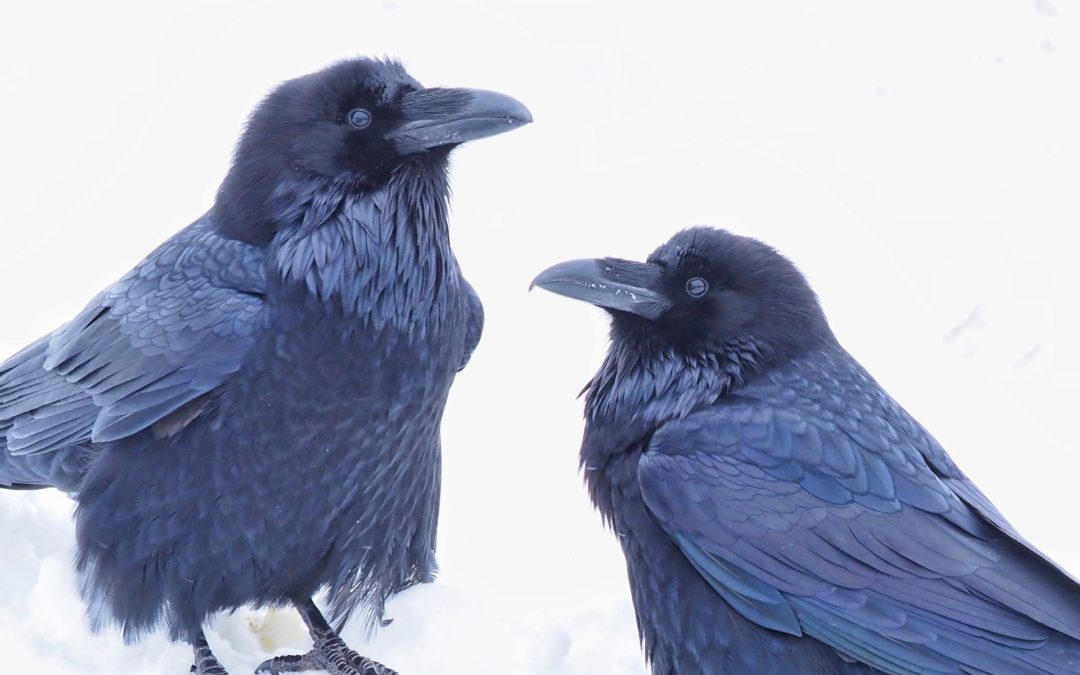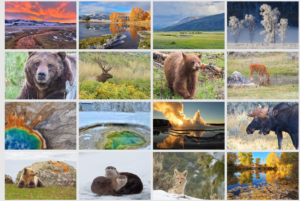Have you ever wished you could speak raven, or at the very least wished you could understand what they are saying? Maybe instead of raven language, you would want to speak chickadee, badger, or barred owl, but whatever the case, there is an incredible world awaiting you just beyond the language barrier. Am I saying you can become a veritable Dr. Doolittle with one simple blog post? Not quite, BUT I can get you way closer to knowing what’s going on in your local forests and hedgerows than you ever thought possible. Though freely conversing with a cottontail rabbit or a kookaburra may not quite be in the cards, you can start to make some inroads into understanding the language of a non-human being with a few simple adjustments to your everyday routine.
Learning raven language
Learning raven language did not happen overnight. I had heard the “kaw, kaw, kaw” so many times that I almost quit listening. If I was out birding and heard the introductory note from Corvus corax, I would scribble its name on the species list for the day, and that was about it. The process of finding a deeper appreciation for ravens came with a growing attention to periodic insights, fueled by little more than basic curiosity. “Why is that raven on that same fence post again?” “Every time I hear that bird, it’s just “kaw, kaw, kaw”.” Thoughts such as these bordered on ennui, were much more important than one might think. Animals have a number of obligatory tasks in life, just like we do, and they result in clear, repeated patterns. The most powerful entry point to learning raven-speak, or any other animal language, is to identify these oft-seen habits. You may know some of them already—but now is the time to recognize them for what they really are—your toe in the doorway to the “room where it happens!”
When I first began noticing ravens during our time living at the Lamar Valley Buffalo Ranch in northern Yellowstone Park, the most common thing I saw them doing was sitting on top of the corral archway and calling in that typical way—”kaw, kaw, kaw”. This was noticed as I went about my usual day stacking firewood, walking to the bunkhouse building, visiting with students in the driveway, etc. I wasn’t studying ravens in the way you think of a biologist doing, I was simply noticing. And so it was for weeks and months. Sometimes I’d see them along the road doing the roadkill ‘thing,’ at other times I just saw them flying overhead, and that was about it. But with that established, I had a foundation to make sense of the next layers beneath the ebony bird’s feathered exterior.
Try this at home!
In your own backyard, try doing something similar by building your raven (or crow, cardinal, or toad) awareness in the small snippets along your dog walk, while getting the mail or catching the bus. In these ‘in-between times,’ you can often tune into the most common behaviors from your local animals by simply using the time you already have, better. Before you know it, your mental file folder on crows, ravens or chipmunks will quickly add up. You will automatically pick up on new things and make associations without even realizing it. With a solid starting point, you can start looking for meaning in all those croaks and caws, chirps and warbles, yips and howls. Simply stated, start looking for what’s different.
As the summer went on in Lamar, I came to realize that the two on the corral fence were the resident, territory-holding pair. When there were more than two, it was either a group of fledged chicks or a gathering around a food source. The more I started to pay attention to those ravens, it became apparent that there were other behaviors going on; things I had missed. Sometimes I would see 20 or 30 ravens at a time, and boy were they noisy! In other instances, I might see just one bird down on the ground, and it was absolutely silent. And now that I thought of it, they were also saying more than just the three “kaws” as well. Try this yourself: count the number of croaks, whistles or chips made by the most common animals in your area and see what you find. Be mindful that messages are being conveyed all the time, and note that not all of them are spoken either. Sometimes just observing the number or location of the animals can tell you a lot. Keep watching… it’s about to get good!
Day by day, the ravens of Lamar revealed their world to me. There were loud and soft versions of the same vocalizations. The typical three-note call of the resident pair might be extended to four, five, six or more notes. This extended territorial call was often used in settings where I, or others pulled into a picnic area or a pullout along the road. It seemed like the resident ravens would key up and start announcing themselves more vociferously, almost as if to say, “See these people? Anything they have or leave behind is mine!” Though it is purely associative, I infer that this sound reflects their excitement and possessiveness over whatever snacks and treats the humans may provide. I have also seen ravens do a similar call over natural food sources of high value, like a bison carcass.
The subtleties of raven language
The range of sounds continued to grow the more I opened my ears and directed my attention. I came to recognize grunts, clicks, clacks, warbles, water droplets falling, grating squawks, screams, cries, hoots, gargles, gurgles, “wah, wahs,” “keeowws” and so many other vocalizations that I can’t even find words to describe. But the simple “kaw,” started it all because it was the most common thing I heard. Another call that was also different from the three-note territorial call was a cacophonous one made when one bird was chasing another. The call is a repetitive up and down “KA, ka, KA, Ka, ka, kaaaaahr, KA, ka” that goes on for several seconds. If the birds could be spotted, I would see one bird chasing another. The aggressor would be trying to force the other bird downward as they flew. The aggressive caller would often be the one behind and above the other. This was typically the resident bird rushing in to deal with a trespasser on its territory. Digging even deeper, I came to hear more variations on this basic theme of a ‘raven on raven’ chase call. I have come to feel there are distinct ones for red tail hawks, another for golden eagles, and another even, for bald eagles.
Many folks know of my uncanny ability to mimic ravens. I find mimicry is a great way to start learning any language whether it’s Portuguese, German or Ravenese. There are two important things to know about doing your own mimicry: 1) its important to try imitating your local animals, even if badly so, as a learning tool (maybe when alone in the car or in the shower so you don’t feel embarrassed, snicker) and 2) it’s a good idea to keep imitations indoors or under your breath. To the first point, I wholeheartedly recommend that you try imitating birds and other animals as an aid in learning. As you probably know, we often learn better by doing than by passive observation. Engaging different parts of our mind and body, including our vocal cords, helps to recall things better. I found this to be the case when I was studying ornithology; there was so much information, I found that I remembered the birds I imitated, the best. If want to recall a new bird or a novel song, use all of the tools at your disposal. What sounds you hear? Take photos, pencil sketches, make phonetic descriptions, pull out your bird app on your phone, mimic their vocalizations. Anything you can do that gets you activated beyond pushing a shutter release or the record button, and you’re going to be a lot further ahead.
Second, when I do raven calls outside, I do it under my breath. Being subtle about mimicry allows me to act upon the impulses that help me learn and remember better, but does not change the scene that’s unfolding. Why wouldn’t I call the ravens when I’m out there with them? If basing our interpretations of raven language comes from the behaviors they are associated with, it’s best not to alter the behaviors! The real reason too, is that I really don’t know what I’m saying. Yeah, I think I figured out a few raven calls but there is a ton of variety out there and I just don’t want to be rude. The value of being silent opens up the chance to see what the birds are doing independently of my presence. We humans dictate what animals do almost everywhere on this planet and I just take the philosophy that I should be quiet, listen and learn. Remember too, that it’s illegal to call to the animals in places like Yellowstone Park and similar protected areas. That said, there are definitely instances outside of protected areas, and where appropriate, that calling an animal can be a great thrill, especially when in the company of a child who you are introducing to the outdoors. But sparing in how much you use recorded or vocalized imitations. Follow your instincts, and keep the animal’s welfare in mind, and have fun!
Pose some questions to yourself as you start to peel back the layers of animal communication. Look for behavioral associations you witness, and in no time you will be finding amazing things. Make the most of your ‘in-between times’ to dig deeper into the language of ravens and other animals as a way to carve your own version of the Rosetta stone. The reason I started with ravens is because they were the most common species around our home. Who’s around your place? This might be your first step to entering the language of another species.
Whatever animal you try to get to know, realize that the homework you put in, will equate to the understanding you get out of it, AND what you uncover will translate to many other species out there. It’s like going to the same theater, or even the same production—the show may change a little and actors may differ—but performance is essentially the same. It was never about being handed a corvid dictionary. Sleuthing out how to speak raven language was a journey paved in curiosity and it is an opportunity that is open to anyone. The threshold between our world and theirs has always sitting right under our noses and learning to speak raven was my opportunity to step across that boundary. So, before you jump into the car or as you head off to get the mail, look up, listen, take note and enjoy the show—and before you know it, you will be adding some new vocabulary from another species to your own repertoire !
Want to read more about ravens? Check out To Catch a Raven and Ravens Behaving Badly
Want to learn more about animal language? Sign up for the webinar Secrets of Animal Language: How and Why to Tune in To Wild Conversations Right Now.



